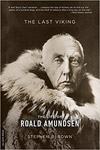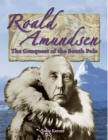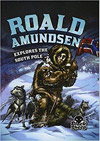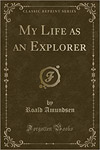
Roald Amundsen - 2
South Pole Expedition, Fram & the War Years - 1910-18
1 - Belgica,
Belgian Antarctic Expedition,
1897 - 1899 - 1st Mate
& Gjoa,
Northwest Passage, 1903-06
- Captain
2 - Fram,
South Pole Expedition,
1911-12 - Expedition Leader
3 - Maud,
Northeast Passage, 1918-25
- Expedition Leader
4 - N24 and N25 Flying
Boats,
North Pole by Air, 1925
5 - Airship Norge,
North
Pole by Air, 1926
6 - The last years
and last journey
to 1928
Roald Engelbregt Gravning Amundsen - 16th July 1872 - 18th June 1928
The South Pole Expedition, Fram, 1910-12
Amundsen's next planned expedition following his success on the Gjoa in the Northwest Passage was to borrow the ship of fellow Norwegian explorer Fritjof Nansen (regarded as being the father of polar travel) the Fram, allow it to freeze into the pack-ice of the Arctic ocean in late summer or autumn to the drift over (or near) to the North Pole with the ice and reach the north pole from there. The Fram was an unusual ship, unlike many polar exploratory ships that started life as merchant-men, coal ships, or the like, the Fram was designed and built for polar travel. It was round bottomed and about a third wide as it was long. The idea being that it was immune to the perils of being stuck in pack ice. Other ships stuck in pack would sometimes succumb to the immense pressures on them and be crushed leaving the occupants stranded on floating seasonal ice with no ship.
The Fram was different in that she would respond to the sideways pressure by being pushed upwards, rising out of the pack to sit above the ice in the way that many small and relatively weak boats had regularly been seen to do when frozen in forming sea ice in the Norwegian Fjords in winter time. Against many expectations, the Fram performed perfectly in this manner.
The planning for the north polar drift was quite advanced when separate claims were made in 1909 by Americans Frederick Cook and Robert Peary to have reached the North Pole by dog sled on the 21st of April, 1908 and the 6th of April 1909 respectively. There was much controversy over whether or not these men had reached the pole, in any case Amundsen had missed his chance of clearly being the first to attain the North Pole and another goal had to be found to satisfy his creditors who had donated or loaned him money for his expedition. He had to deliver them a triumph or he would be ruined with no way to pay back his debts. The new goal became being the first to reach the South Pole.
The Fram left Christiana, Norway in August 1910 with provisions for 2 years and nearly a hundred Greenland sled dogs that were to be the key in his team's subsequent success in reaching the South Pole ahead of Scott and his manhaul party. Only the ships commander Thorvald Nilsen had known of Amundsen's plan to go south in the weeks and months preceding sailing, as far as everyone else was concerned the plan was still to go north and complete what was described as a largely scientific voyage. On the eve of the Fram's departure, another two crew members, Prestrud and Gjertsen were also informed. Not for another month until the ship reached Madeira would the rest of the crew be informed of Amundsen's true intentions.
Amundsen knew that Robert Scott was planning an extensive scientific and exploratory trip to Antarctica at the same time, and claimed that:
"The British expedition was designed entirely for scientific research. The Pole was only a side-issue, whereas in my extended plan it was the main object"
While this had been the official position of the Royal Geographic Society, Scott himself said in his expedition prospectus, that the main objective was:
"..to reach the South Pole, and to secure for the British Empire the honour of this achievement".
"Beg leave inform you proceeding Antarctic. Amundsen."
...which came as a complete surprise to Scott and his crew, they then assumed that he would probably be landing on the Weddell Sea coast. Back in Britain, information gleaned from Norway made it clear that Amundsen must have planning for the South Pole for nearly a year without announcing it, Buenos Aires and Punta Arenas were also mentioned reinforcing the idea he would try from the opposite side of Antarctica to Scott. Amundsen had become regarded as underhanded and dishonourable as a result of his tactics by those involved in Scotts' Expedition.
 Exercising
a dog team in a run out from the Fram
Exercising
a dog team in a run out from the Fram
The Fram and Amundsen's party reached Antarctica and land fall at the Bay of Whales on January 14th 1911 where a winter base was established. Scott's ship the Terra Nova met with the Fram here (Scott was not on board) on the 3rd of Feb 1911 to the surprise of Scott's crew who didn't expect to see them there at all. Amundsen's diary from this period shows that he was very concerned that Scott would beat him to the Pole. While Scott had a team of scientists and a full scientific programme, Amundsen's sole purpose was to be the first to the South Pole, if he didn't do this, his expedition would have been a failure. The contemporary etiquette amongst explorers was that Amundsen should not have been in this area of the Antarctic at this time, he went there and into competition with Scott because of his own financial needs. For his part, Scott writes that he will not change the itinerary of his attempt on the Pole on the basis of Amundsen's largely unknown timings. The concept of the "Race to the Pole" was therefore entirely of Amundsen's making.
 The Fram and Terra Nova (Captains
Scott's ship) unexpectedly meet in the Bay of Whales, Ross
Sea, Antarctica, 4th Feb 1911
The Fram and Terra Nova (Captains
Scott's ship) unexpectedly meet in the Bay of Whales, Ross
Sea, Antarctica, 4th Feb 1911
Amundsen's men set about laying depots until the sun disappeared for the winter in late April, after this without a scientific programme to keep them occupied they were given jobs to prepare for the sled journey to the Pole in the coming spring. With several months to wait every detail could be thought over carefully and repeatedly and all equipment readied as thoroughly as was possible. Amundsen had endured a difficult enforced winter on the Belgica over 10 years beforehand and understood the importance of preparation and of maintaining spirits particularly during the period of 24 hours darkness in the polar night. By the time the winter was ending the team were fully prepared and ready to go.

All of the dogs arranged
on "spans" outside Framheim, 1911.
Amundsen left
Norway with 97 Greenland dogs and arrived with 116.
The only criterion for Amundsen's success was to be the first to the pole, being second would have meant failure as he had no other reason for being in Antarctica, he knew he could leave earlier than Scott because he was using dogs rather than ponies for transport and they were more cold hardy. Driven by this requirement to make his journey as early as possible, Amundsen decided to leave for the pole on the 8th of September with 8 men with sledges, pulled by 86 dogs though against the advice of Hjalmar Johansen, a highly experienced man who had travelled with Nansen on two expeditions, Johansen said it was too early in the season and would be too cold. For the first two days they made good progress but on the third the temperature dropped to -56C (-70F), men and dogs suffered miserably, they went on for another day and built an igloo that night but then Amundsen decided to turn back, the men had got frostbites in their sleep and several dogs froze to death.
The final day of the return happened in a state of disarray with every man for himself, Amundsen, Hanssen and Wisting dashed back with their dog teams oblivious to the other five who struggled, getting lost and progressing more slowly with frost bitten feet and not such good skiing skills. They didn't have a tent or stove with them and they arrived many hours after the first three. The final two, Johansen and Prestrud got back after midnight at the limit of their exhaustion, Johansen had stayed with the less experienced Prestrud to make sure he returned safely.
The next day Johansen angrily brought this subject up with Amundsen in public and as a result was denied a place on the next south pole attempt and made subordinate to Prestrud on a different sledging trip.

One of Amundsen's
depots with snow cairn and a flag marker on the Great Ice Barrier,
November 1911
Amundsen's second attempt to reach the pole left Framheim on the 19th of October 1911 leaving with five men, and four sledges each pulled by thirteen dogs for a total of fifty two. They made good progress feeding the dogs on seal meat and blubber that had been brought with them. The men's rations were meagre in quality, but sufficient in quantity. Amundsen avoided Scott's route to the Polar Plateau up the Beardmore Glacier instead ascending a steeper, more difficult but more direct route up a small glacier he named after Axel Heiberg, one of his financial backers. Seven dogs died on the ice barrier before reaching the glacier, and all but eighteen were killed at the top of the glacier, those killed were eaten eagerly by dogs and men alike, with some depoted for the return journey.
At 3 p.m. on Friday December the 14th 1911 the party arrived at the South Pole. Scott had not beaten them to the prize. They erected a small tent and placed inside it a letter to the King of Norway asking Scott to send it, the party was:
Roald Amundsen
Olav Olavson
Bjaaland
Hilmer Hanssen
Sverre H. Hassel
Oscar Wisting
 Amundsen
and his party at the South Pole, 14th December 1911, Friday,
about 3 p.m.
Amundsen
and his party at the South Pole, 14th December 1911, Friday,
about 3 p.m.
In part mindful of the controversy surrounding the claims of Cook and Peary to have reached the north pole, Amundsen wanted there to be no doubt that he had indeed reached the south pole which was a point on a featureless flat plateau. For the next few days the team took navigational readings at different times of the day and travelled out from the pole along headings at 90 degrees to each other for a few miles to endure they really had reached the South Pole. The best proof of all was that Scott corroborated their navigational readings by arriving at the same point, took pictures of the Norwegians' tent and brought back letters and equipment left there. They left the pole on the 18th of December and arrived back at the Fram on the 25th of January 1912, just 38 days after leaving the south pole and 99 days in all, 10 less than anticipated. They had covered 3,440km (1,860 nautical miles), five men and fifty two dogs had set off, five men and eleven dogs returned.
These eleven surviving dogs would later be given to Douglas Mawson for his Australasian Antarctic Expedition when the Fram and Mawson's ship the Aurora met at Hobart in March 1912 as Amundsen was leaving Antarctic and returning to Norway.
Five days later the Fram left the Bay of Whales, she arrived in Hobart, Australia on the 7th of March. Amundsen had given the impression that he intended to return to Lyttleton New Zealand so as to avoid being met by the press. He found that nothing had yet been heard of Scott, it looked likely that he had won his race. Telegrams were dispatched to Norway and then to the London Daily Chronicle who had bought exclusive rights to his story, he was on his way to making a financial success of his expedition. On the previous Gjoa expedition, other newspapers and reporters had announced his success, so denying him an exclusive sale of the story and being able to fully capitalize on his success.
Amundsen was lecturing under the title "How we reached the Pole" in Sydney, Australia less than a month later in early April 1912 and proceeded to a lecture tour of Britain under the same title. By the time the news of Scott broke nearly a year later in February 1913, he was in the USA giving the same lectures now entitled "Discoverer of the South Pole and Winner in the International Race for the Southern Extremity of the Earth".
Amundsen was seen by many in Britain in particular as being ungentlemanly in his conduct, in private he might be described as underhanded or sneaky. At a dinner at the Royal Geographical Society in London during 1912 attended by Amundsen, the president of the society Lord Curzon made a toast of "I therefore propose three cheers for the dogs!", a thinly veiled insult which clearly stuck with Amundsen as he describes it as such in his memoires written in 1927.
The Crew of the Fram | The "race to the pole", Amundsen v Scott
Between Expeditions, Fame and Fortune, 1912-18
The success of the South Pole expedition, the sale of the story to newspapers and an extensive worldwide lecture tour allowed Amundsen to pay off his creditors, return to solvency and become wealthy enough to not have to work. At that time such lecture tours were one of the main means by which funds could be raised for exploration and creditors of the expedition paid off. He invested his money in Norwegian merchant shipping and doubled it in two years during the First World War.
Amundsen took the criticism he received following his conduct in the way the he "raced" to the South Pole badly and it is said was much troubled by the deaths of Scott and his party, certainly they cast a long and dark shadow over his achievement. He was described as being unhappy afterwards and that the rest of his life was somewhat of an anti-climax. While he was financially more secure, he never achieved the same level of financial success as his hero and mentor Nansen, nor the same adulation or affection from his countrymen.
Amundsen never returned to Antarctica, all of his future exploration would be in the Arctic, it is likely that if he had reached the north pole as initially planned, he would never have returned to Antarctica after the Belgica expedition in 1897-99. As he said in his diary when describing reaching the pole:
-
I had better be honest and admit
straight out that I have never known any man to be placed
in such a diametrically opposite position to the goal of
his desires as I was at that moment. The regions around
the North Pole - well, yes, the North Pole itself - had
attracted me from childhood, and here I was at the South
Pole. Can anything more topsy-turvy be imagined?
International Reactions
Reactions to Amundsen differed, there was a feeling he had deceived everyone by giving the impression he was about to embark on a drift across the North Pole while secretly planning for the South (for a year or more) which meant he had to race to beat Scott if he was to gain the glory and resultant financial rewards. Not for the first time, he had chosen to do what he wanted and hope for forgiveness after the event rather than permission in advance from those who paid the bills. His international lecture tour from 1912 into 1914 drew crowds to hear him speak and describe his adventures on the way to the Pole and back, while the public were supportive and interested, there were variations in the response depending on where he gave the lectures.
In Norway, Amundsen was feted initially and of course his accomplishment was a matter of significant national pride. There was the underlying fact however that he hadn't done what he had said he would when he borrowed the ship of Nansen his mentor, and gained the support of the Norwegian government. The Fram was not Amundsens, it had been built by Nansen and was loaned to Amundsen to drift across the North Pole frozen into the ice when he chose instead to go south. He felt that if he had made his plans public in advance he would have not been allowed to use the Fram, the timing of his announcement from Madeira meant that it was too late for him to be instructed to return the ship after he had sailed for the south with no radio equipment on board.
It was expected by Nansen and the government that after his return from the south, Amundsen would shortly embark on the north-pole drift as originally planned, perhaps as soon as 1912 or 1913, this didn't happen until 1918 in another ship, the Maud.
In August 1912, the crew of the Fram were awarded the "South Pole Medal" by King Haakon of Norway, though it would be a hundred years until 2011 before a monument was erected to Amundsen and his party in Oslo, Norway's capital city.
In Britain Amundsen was sometimes held in fairly low regard, especially after the news of Scott's death arrived in February 1913 and especially by the establishment which at times acknowledged him only grudgingly. Sometimes the attainment of the South Pole was only attributed to Scott with no mention of the Norwegians at all. This should have been of little surprise to Amundsen as his previous expedition on the Gjoa through the Northwest Passage was met with little enthusiasm in Britain to his disappointment.
Britain had a long and active exploring history in both polar regions and it was as a boy reading the Arctic expeditions of Englishman John Franklin, both prior to and including his fateful Northwest Passage attempt that ignited and fuelled Amundsen's fascination for the Arctic and a desire for exploration. As a proud Norwegian it must have affected Amundsen that he was viewed with some caution by the British who were very much a major part of the exploring community amongst whom he chose to live his life and channel his endeavours.
In the United States, the response was more positive, Amundsen was seen more as he saw himself, as the winner in a legitimate race, an achiever modestly presenting himself without appearing overly heroic. His book of the polar journey was reviewed in glowing terms on its publication in early 1913 and he developed a good mutual relationship with the press which gained him many favourable reviews and articles. He was invited to celebratory dinners in many of the towns and cities he visited, souvenirs were made that were sold at his lectures and he and his expedition pictures were used in many advertisements for all manner of things related or otherwise.
The lack of purpose other than reaching the pole was not important here and Amundsen was advised to reduce what scientific content there was in his talks to focus more on the story and entertainment. Such was the degree of acceptance by the Americans that for a time Amundsen pondered on whether he should move to America and become a citizen.

Roald Amundsen, Ernest Shackleton
and Robert Peary, Jan 16th 1913, Philadelphia, USA
Amundsen's next expedition involved traversing the Northeast passage, a route analogous to the Northwest Passage he had successfully traversed in the Gjoa over a decade earlier. He had intended to enter the Bering Strait at Alaska, though the war intervened and his route was in the opposite direction, from Norway, around the top of Scandinavia and along the northern edge of Russia to emerge through the Bering Strait. The plan was to stick close to the coast to begin with and then go further north, allowing the ship to freeze into the ice and drift towards and possibly over the north pole as Nansen had tried to do unsuccessfully in the Fram in 1893.
It had been his intention to embark on this voyage as far back as 1913 when he returned from Antarctica, but he was persuaded to go on a lecture tour to make the most of the money-making opportunities from the south pole journey. His tour continued from 1913 and into 1914 when his future plans were put on hold by the war which everyone expected to be over quickly. Amundsen in the meantime had become enamoured with the new technology of aircraft, he gained the first civilian licence in Norway and intended to take aircraft with him on his voyage to fly from the nearest point the ship could get to the pole to the pole itself. He thought he would be away for 3-5 years.
The expedition was unsuccessful in a number of ways and proceeded in fits and starts over seven years with crew members and Amundsen himself leaving and joining the ship at various times, eventually his ship was seized by creditors and sold to address mounting debts. The war had meant that Amundsen had not been initially able to take his airplane much to his disappointment.
The Fram today is kept at the Fram Museum in Oslo, Norway. After the South Pole expedition she spent many months in tropical waters and fell into a poor state, she was taken back to Norway arriving in 1914 where she was again neglected for some years. Otto Sverdrup took on the task of preserving her and by 1935 she was ashore at Oslo and a building that became the Fram Museum was constructed around her which opened for the first time in May 1936..
Picture - the Fram in the Fram museum in 2018.
Next page - the Maud expedition to the Northeast Passage
Historical pictures from Nasjonalbiblioteket / National Library of Norway, link
Picture of Fram in the museum used courtesy of Palickap under CC BY-SA 4.0 licence.
Roald Amundsen Books and Video

The South Pole:
Roald Amundsen, the Norwegian Antarctic Expedition, 1910-1912

The Last Viking:
The Life of Roald Amundsen

Roald Amundsen's Sled Dogs:
The Sledge Dogs Who Helped Discover the South Pole

Roald Amundsen
The Quest for the South Pole, ages 9-12

The Amundsen Photographs
discovered in 1986, pictures from three of Amundsen's voyages

Roald Amundsen Explores the South Pole
ages 7-10







